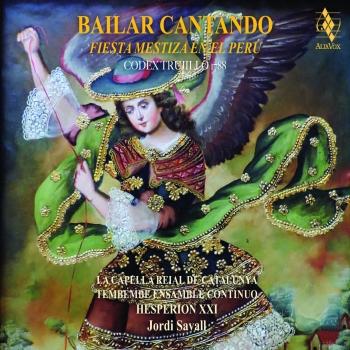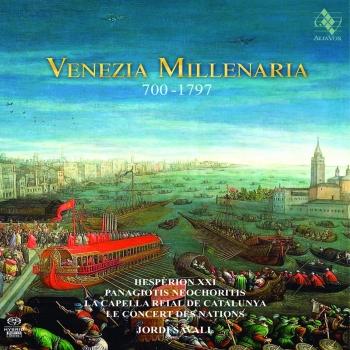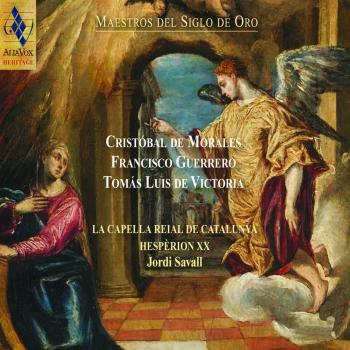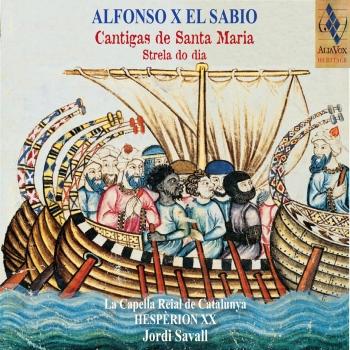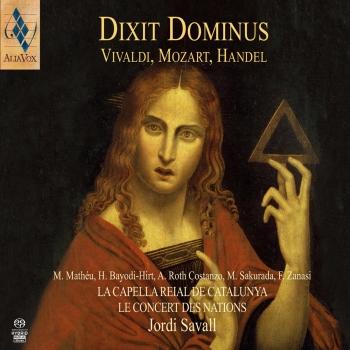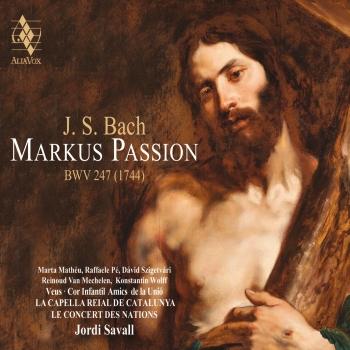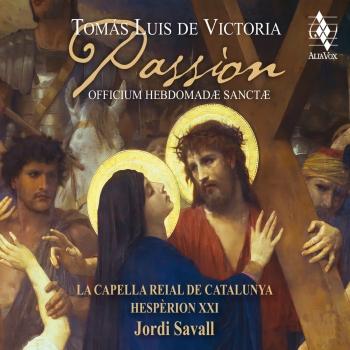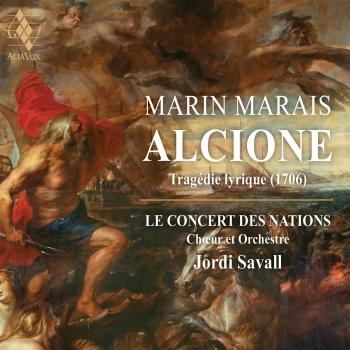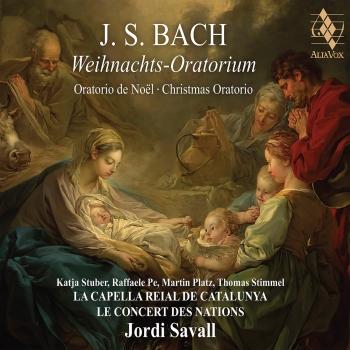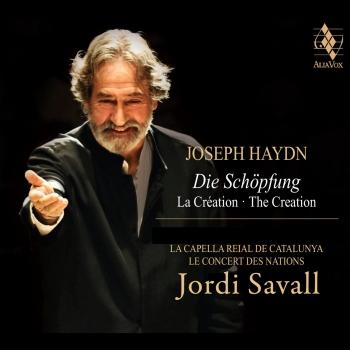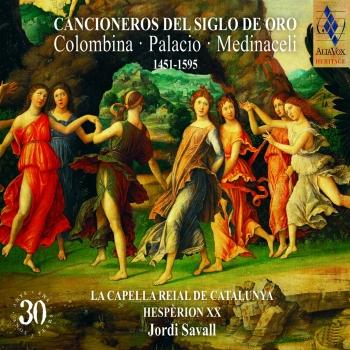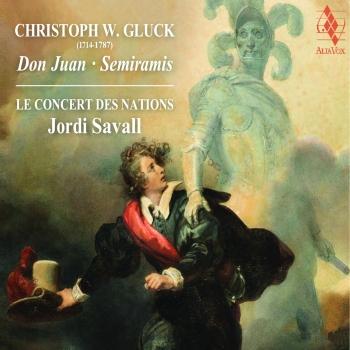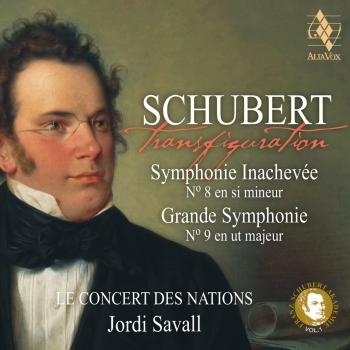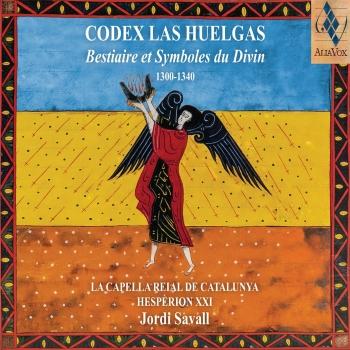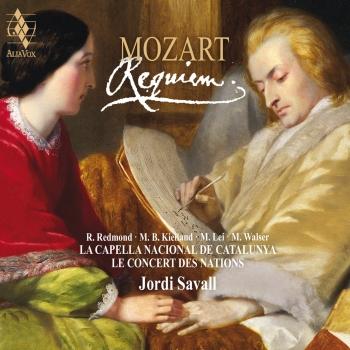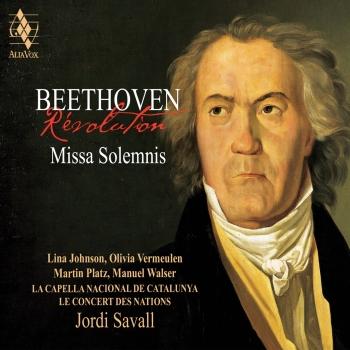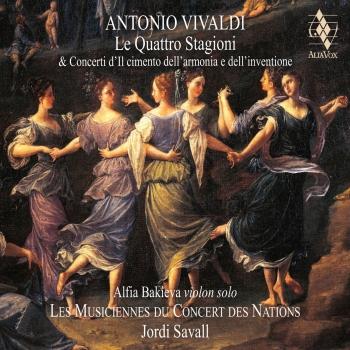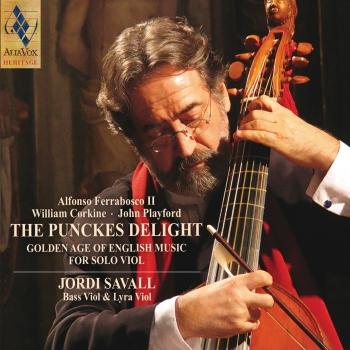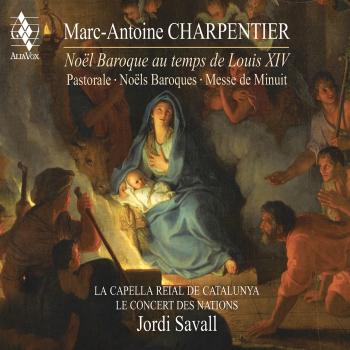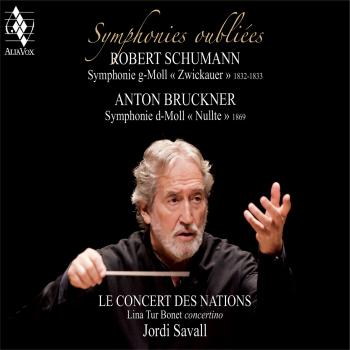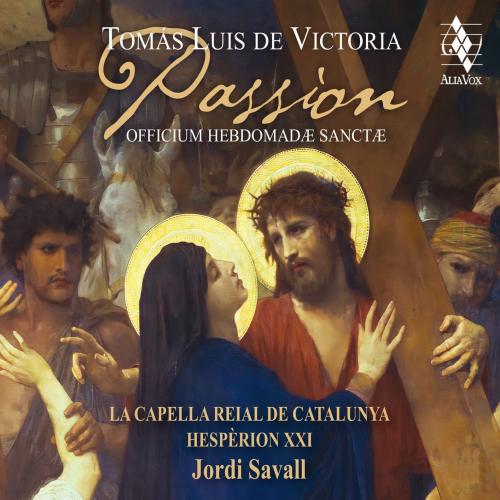
Passion - Officivm Hebdomadæ Sanctæ Jordi Savall
Album info
Album-Release:
2021
HRA-Release:
20.08.2021
Label: Alia Vox
Genre: Classical
Subgenre: Chamber Music
Artist: Jordi Savall
Composer: Tomas Luis de Victoria (1548 - 1611)
Album including Album cover
- Tomas Luis de Victoria (1548 - 1611): Dominica in ramis palmarum:
- 1 Victoria: Dominica in ramis palmarum: Introductio. Unus ex discipulus 00:58
- 2 Victoria: Dominica in ramis palmarum: Antiphona. Hosanna filio David 00:40
- 3 Victoria: Dominica in ramis palmarum: Antiphona. Pueri Hebræorum 02:19
- 4 Victoria: Dominica in ramis palmarum: Passio secundum Mathæum 17:52
- 5 Victoria: Dominica in ramis palmarum: In elevatione Domini. O Domine Jesu Christe 02:23
- Feria quinta in coena domini:
- 6 Victoria: Feria quinta in coena domini: Ad matutinum. Introductio "Eram quasi agnus" 00:43
- 7 Victoria: Feria quinta in coena domini: In primo nocturno. Antiphon. Zelus domus tuæ. Versiculum "Avertantur retrorsum" 00:40
- 8 Victoria: Feria quinta in coena domini: Lamentatio Jeremiae Prophetae. Lectio prima "Incipit Lamentatio Jeremiæ Prophetæ" 00:36
- 9 Victoria: Feria quinta in coena domini: Lamentatio Jeremiae Prophetae. Lectio prima "Aleph. Quomodo sedet" 01:46
- 10 Victoria: Feria quinta in coena domini: Lamentatio Jeremiae Prophetae. Lectio prima "Beth. Plorans ploravit" 01:05
- 11 Victoria: Feria quinta in coena domini: Lamentatio Jeremiae Prophetae. Lectio prima "Jerusalem, convertere ad Dominum" 01:05
- 12 Victoria: Feria quinta in coena domini: Lamentatio Jeremiae Prophetae. Lectio secunda "Vau. Et egressus est" 02:52
- 13 Victoria: Feria quinta in coena domini: Lamentatio Jeremiae Prophetae. Lectio secunda "Zain" 00:08
- 14 Victoria: Feria quinta in coena domini: Lamentatio Jeremiae Prophetae. Lectio secunda "Antiphona. Recordata est Jerusalem" 00:43
- 15 Victoria: Feria quinta in coena domini: Lamentatio Jeremiae Prophetae. Lectio secunda 00:41
- 16 Victoria: Feria quinta in coena domini: Lamentatio Jeremiae Prophetae. Lectio secunda "Jerusalem, convertere ad Dominum" 01:13
- 17 Victoria: Feria quinta in coena domini: Lamentatio Jeremiae Prophetae. Lectio tertia "Introductio" 00:17
- 18 Victoria: Feria quinta in coena domini: Lamentatio Jeremiae Prophetae. Lectio tertia "Jod. Manum suam" 02:03
- 19 Victoria: Feria quinta in coena domini: Lamentatio Jeremiae Prophetae. Lectio tertia "Caph. Omnis populus" 01:45
- 20 Victoria: Feria quinta in coena domini: Lamentatio Jeremiae Prophetae. Lectio tertia "Jerusalem, convertere ad Dominum" 01:27
- 21 Victoria: Feria quinta in coena domini: In secundo notturno. Introductio "Tenebrae factae sunt" 00:32
- 22 Victoria: Feria quinta in coena domini: In secundo notturno. Versiculum "Deus meus eripe me" 00:22
- 23 Victoria: Feria quinta in coena domini: Sex tenebrae responsoria. Quartum Responsorium "Amicus meus" 02:40
- 24 Victoria: Feria quinta in coena domini: Sex tenebrae responsoria. Quintum Responsorium "Judas mercator pessimus" 02:11
- 25 Victoria: Feria quinta in coena domini: Sex tenebrae responsoria. Sextum Responsorium "Unus ex discipulis" 02:58
- 26 Victoria: Feria quinta in coena domini: In tertio notturno. Versiculum "Exsurge Domine" 00:16
- 27 Victoria: Feria quinta in coena domini: In tertio notturno. Septimum Responsorium "Eram quasi agnus" 03:06
- 28 Victoria: Feria quinta in coena domini: In tertio notturno. Octavum Responsorium "Una hora" 02:32
- 29 Victoria: Feria quinta in coena domini: In tertio notturno. Nonum Responsorium "Seniores populi" 04:23
- 30 Victoria: Feria quinta in coena domini: Ad laudes. Introductio "Amicus meus" 01:02
- 31 Victoria: Feria quinta in coena domini: Ad laudes. Canticum Zachariæ "Benedictus Dominus" 05:48
- 32 Victoria: Feria quinta in coena domini: Ad laudes. Psalmus 50 "Miserere mei" 08:22
- 33 Victoria: Feria quinta in coena domini: In elevatione corporis christi. In Missa Tantum ergo. Hymnus "Pange Lingua" 03:40
- Feria sexta in passione Domini:
- 34 Victoria: Feria sexta in passione Domini: Ad matutinum. Introductio "Ecce quomodo" 01:06
- 35 Victoria: Feria sexta in passione Domini: In primo nocturno. Antiphona "Astiterunt reges terrae" 00:22
- 36 Victoria: Feria sexta in passione Domini: Lamentatio Jeremiae Prophetae. Lectio prima "Heth" 02:05
- 37 Victoria: Feria sexta in passione Domini: Lamentatio Jeremiae Prophetae. Lectio prima "Jerusalem, convertere ad Dominum" 01:17
- 38 Victoria: Feria sexta in passione Domini: Lamentatio Jeremiae Prophetae. Lectio secunda "Lamed. Matribus suis dixerunt" 01:13
- 39 Victoria: Feria sexta in passione Domini: Lamentatio Jeremiae Prophetae. Lectio secunda "Mem. Cui comparabo te?" 02:14
- 40 Victoria: Feria sexta in passione Domini: Lamentatio Jeremiae Prophetae. Lectio secunda "Jerusalem, convertere ad Dominum" 01:08
- 41 Victoria: Feria sexta in passione Domini: Lamentatio Jeremiae Prophetae. Lectio tertia "Aleph. Ego vir videns" 01:18
- 42 Victoria: Feria sexta in passione Domini: Lamentatio Jeremiae Prophetae. Lectio tertia "Aleph. Meminavit" 01:22
- 43 Victoria: Feria sexta in passione Domini: Lamentatio Jeremiae Prophetae. Lectio tertia "Jerusalem, convertere ad Dominum" 01:22
- 44 Victoria: Feria sexta in passione Domini: In secundo notturno. Introductio "Eram quasi agnus" 01:01
- 45 Victoria: Feria sexta in passione Domini: In secundo notturno. Antiphona "Vim faciebant" 00:15
- 46 Victoria: Feria sexta in passione Domini: In secundo notturno. Versiculum "Insurrexerunt in me" 00:17
- 47 Victoria: Feria sexta in passione Domini: Sex tenebrae responsoria. Quartum Responsorium "Tanquam ad latronem" 03:15
- 48 Victoria: Feria sexta in passione Domini: Sex tenebrae responsoria. Quintum Responsorium "Tenebrae factae sunt" 03:18
- 49 Victoria: Feria sexta in passione Domini: Sex tenebrae responsoria. Sextum Responsorium "Animam meam dilectam" 06:14
- 50 Victoria: Feria sexta in passione Domini: In tertio notturno. Versiculum "Locuti sunt adversum me lingua" 00:24
- 51 Victoria: Feria sexta in passione Domini: In tertio notturno. Septimum Responsorium "Tradiderunt me" 02:28
- 52 Victoria: Feria sexta in passione Domini: In tertio notturno. Octavum Responsorium "Jesum tradidit impius" 02:46
- 53 Victoria: Feria sexta in passione Domini: In tertio notturno. Nonum Responsorium "Caligaverunt oculi mei" 04:29
- 54 Victoria: Feria sexta in passione Domini: Ad laudes. Introductio "Tenebrae factae sunt" 00:30
- 55 Victoria: Feria sexta in passione Domini: Ad laudes. Passio secundum "Joannem" 13:43
- 56 Victoria: Feria sexta in passione Domini: In adoratione crucis. Introductio "Aleph" 00:28
- 57 Victoria: Feria sexta in passione Domini: In adoratione crucis. Vere languores 03:17
- 58 Victoria: Feria sexta in passione Domini: In adoratione crucis. Antiphona "Ecce lignum Crucis" 00:36
- 59 Victoria: Feria sexta in passione Domini: Improperia. Popule meus 04:53
- Sabbato sancto:
- 60 Victoria: Sabbato sancto: Ad matutinum. Introductio "Heth" 00:24
- 61 Victoria: Sabbato sancto: Ad matutinum. Antiphona & Versiculum "In pace et idipsum" 00:32
- 62 Victoria: Sabbato sancto: Lamentatio Jeremiae Prophetae. Lectio prima "Heth. Misericordiæ Domini" 01:18
- 63 Victoria: Sabbato sancto: Lamentatio Jeremiae Prophetae. Lectio prima "Teth. Bonum est viro" 01:17
- 64 Victoria: Sabbato sancto: Lamentatio Jeremiae Prophetae. Lectio prima "Jerusalem, convertere ad Dominum" 01:27
- 65 Victoria: Sabbato sancto: Lamentatio Jeremiae Prophetae. Lectio secunda "Beth" 00:23
- 66 Victoria: Sabbato sancto: Lamentatio Jeremiae Prophetae. Lectio secunda: "Aleph. Quomodo obscuratum est" 01:31
- 67 Victoria: Sabbato sancto: Lamentatio Jeremiae Prophetae. Lectio secunda "Beth. Filii Sion inclyti" 01:21
- 68 Victoria: Sabbato sancto: Lamentatio Jeremiae Prophetae. Lectio secunda "Jerusalem, convertere ad Dominum" 01:52
- 69 Victoria: Sabbato sancto: Lamentatio Jeremiae Prophetae. Lectio secunda "Versiculum. Tu exsurgens, Domine" 00:37
- 70 Victoria: Sabbato sancto: Lamentatio Jeremiae Prophetae. Lectio tertia "Incipit oratio Jeremiæ" 00:21
- 71 Victoria: Sabbato sancto: Lamentatio Jeremiae Prophetae. Lectio tertia "Recordare" 01:32
- 72 Victoria: Sabbato sancto: Lamentatio Jeremiae Prophetae. Lectio tertia "Pupili facti sumus" 02:02
- 73 Victoria: Sabbato sancto: Lamentatio Jeremiae Prophetae. Lectio tertia "Jerusalem, convertere ad Dominum" 02:36
- 74 Victoria: Sabbato sancto: In secundo notturno. Introductio "Astiterunt" 00:58
- 75 Victoria: Sabbato sancto: In secundo notturno. Antiphona "Elevamini portæ eternales" 00:19
- 76 Victoria: Sabbato sancto: In secundo notturno. Versiculum "Tu autem, Domine" 00:18
- 77 Victoria: Sabbato sancto: Sex tenebrae responsoria. Quartum Responsorium "Recessit pastor noster" 02:56
- 78 Victoria: Sabbato sancto: Sex tenebrae responsoria. Quintum Responsorium "O vos omnes" 02:23
- 79 Victoria: Sabbato sancto: Sex tenebrae responsoria. Sextum Responsorium "Ecce quomodo moritur" 04:01
- 80 Victoria: Sabbato sancto: In tertio notturno. Antiphona "Deus adjuvat me" 00:14
- 81 Victoria: Sabbato sancto: In tertio notturno. Versiculum "In pace factus est locus ejus" 00:17
- 82 Victoria: Sabbato sancto: In tertio notturno. Septimum Responsorium "Astiterunt reges" 02:01
- 83 Victoria: Sabbato sancto: In tertio notturno. Octavum Responsorium "Æstimatus sum" 02:06
- 84 Victoria: Sabbato sancto: In tertio notturno. Nonum Responsorium "Sepulto Domino" 03:20
- 85 Victoria: Sabbato sancto: Ad laudes. Introductio "Amicus meus" 01:01
- 86 Victoria: Sabbato sancto: Ad laudes. Canticum Zachariæ "Benedictus Dominus" 05:48
- 87 Victoria: Sabbato sancto: Ad laudes. Psalmus 50 "Miserere mei" 08:22
- 88 Victoria: Sabbato sancto: Hymnus Vexilla regis more hispano 08:57
Info for Passion - Officivm Hebdomadæ Sanctæ
Tomás Luis de Victoria’s OFFICIUM HEBDOMADÆ SANCTÆ is one of the most compelling examples of creative genius in a composer, a toweringly poignant and masterpiece on the Passion of Christ, a pure but infinitely subtle creation, Ad majorem Dei gloriam.
More than 70 years ago, the sequences of Gregorian chant and polyphonic music such as that of Tomás Luis de Victoria made a profound impression on Savall's musical experience at that time from 1949 to 1953, when he was a chorister under the direction of Joan Just in the boys' choir of the Piarist school at Igualada, Catalonia. To have been submerged in the beauty of that music during his childhood unquestionably made a lasting impact and shaped certain aspects of his education as a chorister, and particularly his musical sensibility. The memory of those spellbinding chants also had a decisive influence on his choice to study the cello a few years later, just before he turned 15, when he was spellbound one evening at a rehearsal of Mozart's Requiem. It was after that evening of extraordinary intensity, and thanks to Joan Just, who conducted the choir of the Schola Cantorum in Igualada, that he fully realized the power of music and decided to become a musician.
To embark - well into the 21st century - on the performance of a great religious masterpiece composed more than 400 years ago for the celebration of the liturgical offices of its own very specific age poses a number of crucial questions and as many exceptional challenges. How are we to conceive a present-day interpretation of a composition so intimately associated with Christian worship in the Counter-Reformation, remaining faithful to the composer's intention and the musical practice of his day, whilst at the same time ensuring that it conveys all the work's beauty and spirituality without neglecting its liturgical purpose? What is the essential quality of a work of art which makes it possible for a piece of music composed in 1585 to continue to move and touch us deeply today? To what extent can the artistic dimension of that work of art exist independently of the liturgical context which inspired it? Can we today feel the full spiritual force and beauty of these Gregorian chants and ancient polyphonies completely independently of the liturgical purpose for which they were created? How can we, as musicians and singers of the 21st century, truly grasp the profound spiritual message and the artistic sense that Tomás Luis de Victoria conveys in this colossal masterpiece?
Ultimately, the answers to all these questions are to be found in the music; in other words, in the last analysis, it is the essence of the music itself which provides the key to unlocking its mystery. We know that music admits no duplicity, least of all the music of Victoria, and that is why the utmost purity of commitment and sensibility are required of the performers: each voice, each instrument must own the profound meaning of each melody and modulation, sharing with the other voices the absolute need to find meaning and, above all, "grace." As La Fontaine said, "Cette grâce plus belle que la beauté" ("That grace which is more beautiful than beauty itself") because it directly touches our soul. So before all else, we must study the original document, since any transcription is in itself an interpretation. First of all, we had to study the original edition of the collection printed at Rome in 1585 under the title OFFICIUM HEBDOMADÆ SANCTÆ, and subsequently the corresponding Gregorian antiennes, especially in the case of the Passions, where Victoria composed only some of the verses (21 verses for the St. Matthew and 14 for the St. John), corresponding to the passages in which several characters intervene.
In contrast to other pieces from the Officium, such as Tantum ergo, Vexilla regis, written in the "moro hispano," or Spanish style, in the two Passions Victoria uses the Gregorian chant customary in the Roman tradition. Savall and company, therefore, based their reconstruction of the Evangelist's and Jesus's Gregorian parts, corresponding to the two Passions according to St. Matthew and St. John included in the Officium, on Giovanne Domenico Guidetti (JOHANNE GVIDETTO BONONIENS in the printed edition) CANTUS ECCLESIASTICUS (brilliantly performed and sung by "cantor" and celebrant Andrés Montilla-Acurero).
La Capella Reial de Catalunya
Hespèrion XXI
Jordi Savall, conductor
Jordi Savall
Born on August 1, 1941, in Igualada, near Barcelona, Spain; married Montserrat Figueras (a musician), 1968. Education: Barcelona Conservatory, diploma; Schola Cantorum Basiliensis, diploma, 1970. Addresses: Record company---Naive Classique, 148 rue du Faubourg Possinière, 75010 Paris, France.
The works performed by Catalan gambist and conductor Jordi Savall span several centuries---from the music of Alfonso el Sabio, king of Castile and Léon, to the works of J. S. Bach---bringing to life the splendor and passion of bygone eras. A performance by Savall is more than a musical experience: the extraordinary power and beauty of his playing magically removes the listener from the flux of time, creating a space in which such obstacles to enjoyment as historical distance, stylistic peculiarities, and idiomatic enigmas simply disappear. For example, historical periods, including the Baroque, have often been described as "distant." Indeed, the physical and mental universe of seventeenth-century France may seem distant to a person living in the twenty-first century. But that distance vanishes when Savall plays the music of the great French master of the bass viol, Marin Marais.
First of all, Savall's main instrument is the viola da gamba, or bass viol (he also plays the smaller viols), not as a quaint relic that needs some special justification or antiquarian explanation. True, in the late 1700s, the viola da gamba---which is not a different kind of cello, but a member of the viol family, a distinct group of instruments of varying sizes---was supplanted by the cello, as the latter instrument, with its potential for virtuosity, satisfied the requirements of changing musical styles. However, to Savall, his instrument is irreplaceable. In fact, according to Savall, the viola da gamba has a particular sonic richness that the more "modern" cello lacks. As Savall explained to Chris Pasles of the Los Angeles Times, the "viola da gamba is totally different from a cello. It's closer to the lute---a lute with a bow, in fact. With six strings, frets like a guitar, a softer sound, it's more rich in different colors." Instead of merely reproducing a particular musical composition, Savall captures and expresses the timeless humanity of the music, illuminating the particular composition as a universally comprehensible document of the human experience. A case in point is Savall's mesmerizing performance of Marais's musical description, found in Book V of his Pièces de viole, of his gallstone operation. Written under the influence of François Couperin's character pieces, this extraordinary composition, especially in Savall's version, remains one of the most suggestively dramatic works of Baroque music.
Born in 1941, near the Catalan city of Barcelona, Savall began his musical education at the age of six. After graduation from the Barcelona Conservatory, where he studied the cello, Savall went to Basel, Switzerland, where he studied the viola da gamba with August Wenzinger at the Schola Cantorum Basiliensis, receiving a diploma in 1970. His other teachers included Wieland Kuijken, in Brussels. In 1973 Savall took over Wenzinger's post at the Schola Cantorum. By the early 1970s, Savall was already considered one the greatest viola da gamba players. In addition, he worked hard to enrich his instrument's repertoire, rescuing many works from oblivion and performing and recording numerous forgotten compositions. Savall thus exemplified, as he still does, the learned performer, who constantly studies the vast field of old music, bringing many neglected compositions to light. Among these lesser-known compositions are works by Marais, whose rich and fascinating oeuvre includes more than 500 pieces for viola da gamba and keyboard accompaniment, assembled in five books of his Pièces de viole.
In 1974 Savall and his wife, soprano Montserrat Figueras, founded Hespèrion XX---later, in the twenty-first century, known as Hespèrion XXI---an international ensemble that has gained great acclaim for its extraordinary performances of music from the Middle Ages to the Baroque. In 1987, returning to his native city after his extensive sojourn in foreign lands, Savall formed the Capella Reial de Catalunya, a vocal group that, under his direction, has performed and recorded music by Tomáa Luis de Victoria, Francisco Guerrero, and Claudio Monteverdi.
In 1989, further expanding his repertoire and musical activities, Savall founded the Concert des Nations, an ensemble consisting of younger musicians from Spain and Latin America. Under Savall's direction, this orchestra, which plays on period instruments, has recorded a variety of works from the Baroque and Classical periods.
Savall's career received a tremendous boost when film director Alain Corneau asked him to play on the soundtrack for Tous les matins du monde, his 1992 film about Marais and his teacher, Sainte-Colombe. Based on Pascal Quignard's admirable 1991 novel--available in English as All the World's Mornings--which imagines the life of the mysterious Sieur de Sainte-Colombe, the film is a spell-binding portrait of seventeenth-century France with the music, performed by Savall, providing a foundation for the narrative. Savall himself indirectly inspired Quignard's novel: it was a 1976 recording by Savall that introduced the writer to Sainte-Colombe's music. The music that Savall performs on the soundtrack is mostly by Marais and Sainte-Colombe, though it also includes a segment of François Couperin's deeply spiritual Leçons des ténèbres. Savall is inspired in his performance of the heartrending Tombeau les regrets, which, in Quignard's imagination, Sainte-Colombe played to conjure up the spirit of his deceased wife. In Savall's hands, this music, which appears as a leitmotif throughout the film, graces the rich tapestry of the film as a mysterious aura.
In 1988 the French Ministry of Culture awarded Savall the title of Officier de l'Ordre des Arts et Lettres. His recordings, numbering more than one hundred, have received many awards, including the Double Disc of Gold and the Diapason d'Or. In 1997 Savall's recording company, Astrée, founded a separate label, Fontalis, for his recordings. The following year, Savall started his own label, Alia Vox, which later reissued many of his earlier recordings at an affordable price. Savall's remarkable career is more than a personal triumph: thanks to his superb musicianship, the viola de gamba has emerged from the shadows of the past, becoming the instrument of choice for many younger performers. For such performers, the rich repertoire of the Renaissance and Baroque offers not only infinite artistic challenges and possibilities but the opportunity to abolish the somewhat artificial barrier separating "early" music from the rest of the musical tradition. (Zoran Minderovic)
This album contains no booklet.










